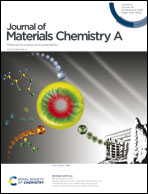Tailoring tantalum doping into a perovskite ferrite to obtain a highly active and stable anode for solid oxide fuel cells†
Abstract
Some perovskite ferrites suffer from phase decomposition in a reducing environment, and incorporation of high-valence cations, such as Nb5+ and Ti4+/3+, is an effective method to stabilize the ferrites. Herein, we rationally introduce pentavalent tantalum on the B-site of La0.8Sr0.2FeO3−δ (LSF) to prepare novel perovskites La0.8Sr0.2Fe0.95Ta0.05O3−δ (LSFTa05) and La0.8Sr0.2Fe0.9Ta0.1O3−δ (LSFTa10), and evaluate their electrochemical performance as SOFC anodes. The structural stability of LSF is notably improved but the oxygen vacancy content is decreased after Ta doping. LSFTa05 is the most promising anode among the three candidates due to its best performance after 50 h of operation (441.7 mW cm−2 at 800 °C in wet H2) and considerable coking and sulfur resistance. Finally, DFT calculations are performed to study the mechanisms of stability and conductivity of the ferrites with different Ta contents. Our work highlights that LSFTa05 is a high-performance and robust alternative perovskite anode, and could provide valuable insights into developing high-valence cation-stabilized perovskite anodes for SOFCs.



 Please wait while we load your content...
Please wait while we load your content...